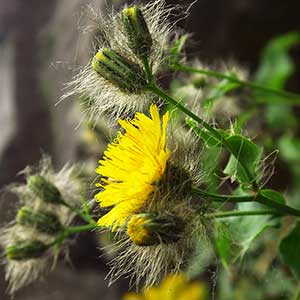Hieracium longiberbe
Hieracium vulgatum
long-bearded hawkweed, longbeard hawkweed
proximally piloso-hirsute (hairs 2–8+ mm), sometimes glabrate, distally glabrous or piloso-hirsute (hairs 2–5+ mm).
proximally piloso-hirsute (hairs 1–3+ mm), distally stellate-pubescent and stipitate-glandular, sometimes piloso-hirsute as well (hairs 1–2+ mm).
basal 0(–3+), cauline 6–12+;
blades spatulate to oblanceolate, 25–80(–100+) × 8–15(–25+) mm, lengths 3–5 times widths, bases ± cuneate, margins usually entire, rarely denticulate, apices obtuse to acute, abaxial faces piloso-hirsute (hairs 2–5+ mm), adaxial usually piloso-hirsute at margins (hairs 2–5+ mm), rarely glabrous.
basal 3–8+, cauline 1–5+;
blades (often purple-mottled) lance-elliptic to lanceolate, 50–100 × 10–50+ mm, lengths 2–5 times widths, bases usually cuneate, sometimes rounded to truncate, margins ± dentate or entire, apices acute, faces usually ± piloso-hirsute (at least near margins, hairs 1–3+ mm), sometimes glabrate.
usually stellate-pubescent, sometimes piloso-hirsute and/or stipitate-glandular as well, rarely glabrous.
stellate-pubescent and stipitate-glandular.
campanulate, 7–10 mm.
± obconic, 8–10 mm.
12–24+;
corollas yellow, 7–12 mm.
40–80+;
corollas yellow, 13–18 mm.
12–15+, apices ± rounded, abaxial faces piloso-hirsute and stellate-pubescent.
ca. 21+, apices acute to acuminate, abaxial faces stellate-pubescent and stipitate-glandular.
bractlets 9–13+.
bractlets 13–16+.
(3–)6–12+ in corymbiform arrays.
(1–)3–9+ in corymbiform arrays.
columnar, ca. 3.5 mm;
pappi of 32–40+, white or stramineous bristles in ± 2 series, 5–6 mm.
columnar, 2.5–3 mm;
pappi of 30–40+, stramineous bristles in ± 2 series, ca. 5 mm.
Hieracium longiberbe
Hieracium vulgatum
Hieracium longiberbe is known only from along the Columbia River.
(Discussion copyrighted by Flora of North America; reprinted with permission.)
The correct name for the species here called Hieracium vulgatum may be H. lachenallii C. C. Gmelin (E. Lepage 1971; E. G. Voss 1972–1996, vol. 3). Plants of H. groenlandicum (stems mostly piloso-hirsute and not stipitate-glandular, corolla lobes distally ciliate) are sometimes treated as distinct from H. vulgatum in a narrow sense (stems usually stipitate-glandular and not piloso-hirsute, corolla lobes not ciliate distally).
(Discussion copyrighted by Flora of North America; reprinted with permission.)


